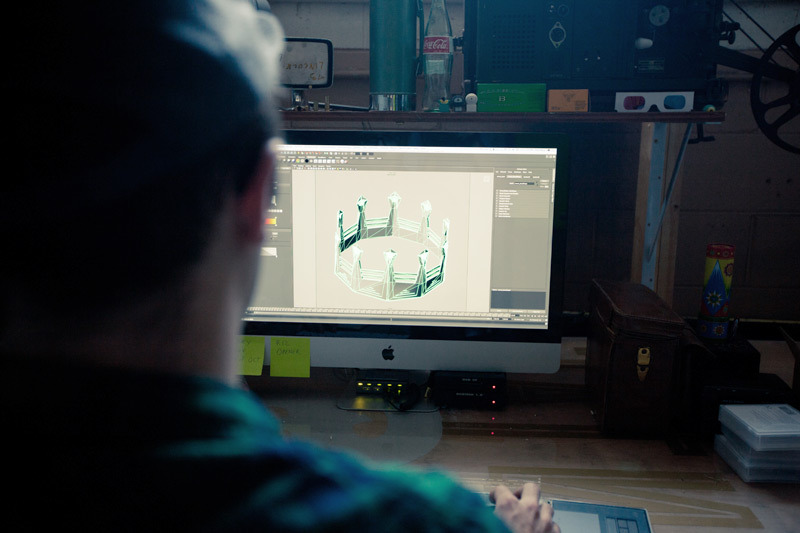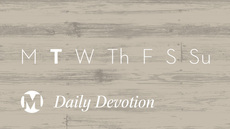We were able to grab some time to chat with the guys responsible for making our Esther sermon series trailer and prologue. What follows is a conversation about how that project was birthed from idea to reality and the blood, sweat, and tears it took along the way.
Mars Hill: What do you do at Mars Hill and what was your role for the Esther project?
Andy Maier: I’m the motion designer and I was the animator for Esther.
Colin Day: I’m the art director, and I led the team on brainstorming and coming up with the look and feel for Esther, how it would work with the story we had written.
Patrick Mahoney: I’m the assistant art director and I was the illustrator and designer on Esther.
John Raines: I’m the film editor and edited Esther.

MH: Can you explain the process of how a series like Esther happens?
CD: Jesse Bryan met with Pastor Mark early on, and Pastor Mark gave him the lowdown on the research that he had done on the series as well as some of his basic observations that would go into the sermon series. Jesse and I talked about what kind of video series would support the pulpit during the sermon series. And he had this idea that we should definitely tell the backstory, because there is so much involved leading up to the time of Esther. We wanted to tell that backstory so that people would get a sense of how big and epic Esther is. An initial script was written then we went into a brainstorming phase where I would meet with the designers and they would bring to the table the different pieces, the illustration, and video material that fit with the theme of Esther.
One of the things we narrowed it down to was working with stark black and white. A lot of that comes from the idea in the Esther series that we don’t see the name of God mentioned at all, but you see a silhouette of God through the work of his powerful hand moving around the pieces on the board of history. So black and white went along with that—the idea of creating shadows and silhouettes. We wanted to make it poetic and clean. From there Patrick came up with a great aesthetic approach to the characters.

PM: After our initial brainstorming meetings, we broke down into smaller teams. My team worked on style and aesthetics. We were working on a lot of patterns, and black and white, with little colors. We wanted to be simple in our illustrations.
JR: By the time design and themes were already in the process of implementation, I was gathering prints of early illustrations and creating a large wall of storyboards. I elucidated transitions, created a few temporary connecting images, and piled on newer versions as they came, while studying a commentary on Esther that was placed alongside the working image templates. It was my initial position in the process to look at the entire film at a glance and help each scene work together as it should.
MH: What were some of the influences and inspirations for your style?
CD: There is an animator from Canada who does a lot of motion graphics. In his personal work he has a really minimalist aesthetic. His character will be a square, a circle, and a triangle. We were really inspired by how this animator was able to tell the story with very few elements. And we knew that the less imagery we used the better the video would be because it would make a cleaner story. He made a piece that was called The Owl that really inspired us. We wanted to find a middle ground between the decorative elements and ornamented brush strokes of someone like Frank Miller, and the stark modernism of Saul Bass. Also, there’s something very solid and rigid about the [architecture of the] First Persian Empire, so we wanted to represent that with very geometric shapes. You’ll notice [in our series art,] Xerxes is a rectangular figure who looks almost looks like a building. But the fabric of his clothing has details and patterns because his clothing was handmade with beautiful, rich materials. Color played a huge role in representation as well. Purple symbolized Xerxes, and green symbolized Esther. As far as inspiration goes, it was not just this animator from Canada. Andy brought up some animation from Kill Bill [Vol. 1] that was really great. […]
We benefitted greatly by volunteers from the church who helped us get some ideas and structure for telling the story of Esther. Darren from Mars Hill Downtown Bellevue is also a concept artist at a video game company. He came up with hand drawn storyboards. This really helped us to sketch the storyboard frames before we even got into animation. So really the whole church was involved in the process.

JR: Since I only worked with images that were arranged in terms of stylization before I received them, I did not have any direct stylistic influence on the subjects themselves. Rather, I adjusted the style of editing, which was rather straightforward. I just attempted to push the spatial boundaries that each individual assumes within the context of each scene.
AM: As an animator, I’m the last link in the chain. Raines helped us with the editorial standpoint. He paced out when scenes occur and how long they occur—this is called animatics, and what it does is it allows me to freely work animation within helpful timeframes. My own philosophy of animation comes from movies like The Rescuers Down Under. In the film, animation often happens on three levels. There are fast, medium, and slow-moving objects. I incorporated this idea into the video. If you look at the frames of the [Esther] prologue, there is always something really still, something moving fast, and slow-moving things.
MH: Do you have a favorite part of the video?
PM: There are parts that are technically detailed. I really like the teeth clamping down. It’s very abstract, but it’s powerful and symbolic.
CD: I would agree with Patrick because the teeth scene goes back to the idea of, how do you tell a story using almost nothing? If you look at the teeth scene, all that is used are straight lines and triangles. The simplicity doesn’t distract from the story, but it gives you a chance to listen to what is being said and let the visuals go along with the actual story. So what you’re hearing about is how this great dragon squashed the people of God. And it’s more important to let everyone focus on what is being said. In some movies, people let the visuals do the whole job, whereas in Christianity it’s more about what we hear and what is said. We wanted the visuals to be subservient to what was being said in the story.

MH: Along the way, were there any hiccups or struggles?
AM: The struggles were in trying to make all the thousands of layers in the video line up. It’s really easy to lose some of those layers. Also, in the middle of Esther, our servers crashed so we lost access to the project for a while and had to work locally. There were also communication hiccups. But God’s grace is evident in all of this, in spite of our hiccups.
JR: I remember there being quite a few difficulties in finding individuals to provide the voices of the characters in Esther. This lasted all the way until the end where we had to administer large last-minute changes. It thankfully turned out fine.
PM: The amount of work was staggering. The majority of the stuff I do is design-related and illustration. Sometimes it would take hours just working on one frame. As the illustrator working with Andy, I had to communicate all the details because he was animating the material I was illustrating.

AM: Patrick also had to design past the margins on the left, the right, up, and down, so that when we were animating we would not run out of space.
CD: We were building a model more than we were building a final shot or a photograph. We would work on some details for a few days, but then for some reason or another that element was not helpful or even confusing. So we all had to be willing to see that for the greater good we had to drop a certain shot, illustration, or animation because it was getting in the way, calling too much attention to itself, or it was too complicated.
I think the story of Esther reflects what we were doing. The idea that God is sovereign and God is working through all of our successes and failures, or God’s perfect work through imperfect people was part of what we were doing. There’s nothing abstract about it at all. We’re going through and bearing witness, too, and seeing our own imperfection, weakness, and need for Jesus in all this. And we had to sacrifice things that we hold dear and think are awesome but aren’t in service to God’s bigger vision. I’m stoked about how the prologue turned out and how it supports the sermon series. If it were up to me, I would have spread this team out way too thin on way too many things at once, and this project would have never gotten done. It was cool to see the theme of Esther playing out in our team before we even went through the sermon series.

MH: This was a lot of work for a small team. What got you through those late nights?
CD: I love thinking about how many churches, filled with people, are benefitting from hearing God’s word and hearing about the gospel through sermons and things we get to be a part of. I kept thinking about the 14 lead pastors of Mars Hill in particular. I think about how those guys labor to tell people about Jesus and see lives transformed when it’s not comfortable or people don’t want to hear them. I’m glad to work hard and late to hand something off to them, to run the ball right to them and hand it off.
PM: My wife was pretty gracious and we worked through that too, in terms of how much time it takes to work. The thing that keeps you going at the end of the day is Jesus: God’s called us to this, and we’re going to do it. The pressure was exciting even though it was painful at times. I couldn’t wait to see what would come out of it.
AM: My wife’s support also was huge. I can get in artist mode and think of myself as an artist behind a computer and really get defensive and overwhelmed. But God taught me that this church is so much bigger than what we can create and put on a screen. God’s changing people’s hearts: there are Redemption Groups, Community Groups, and so much more going on. Jesus’ mission is so much bigger than any of us can grasp.
















